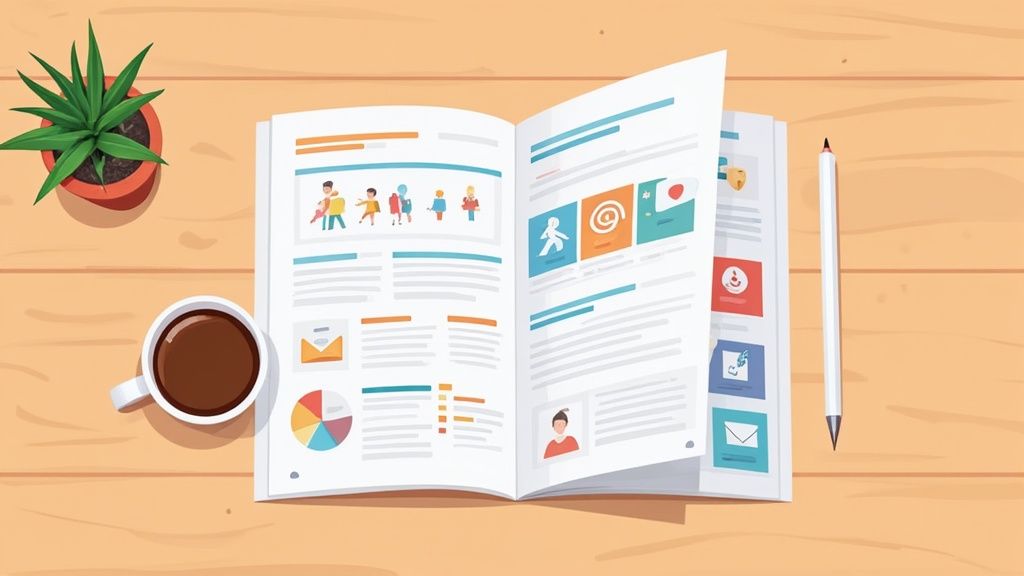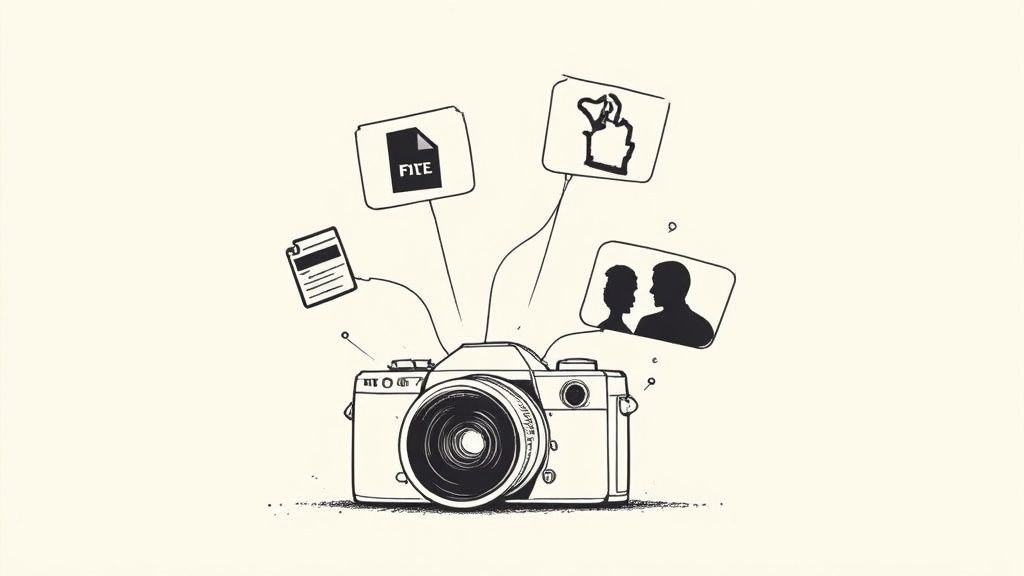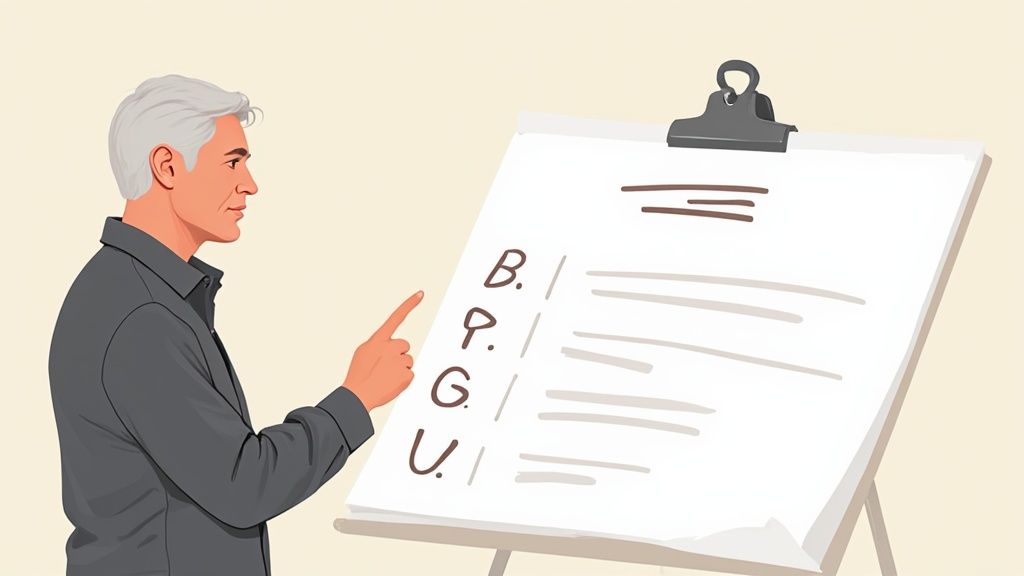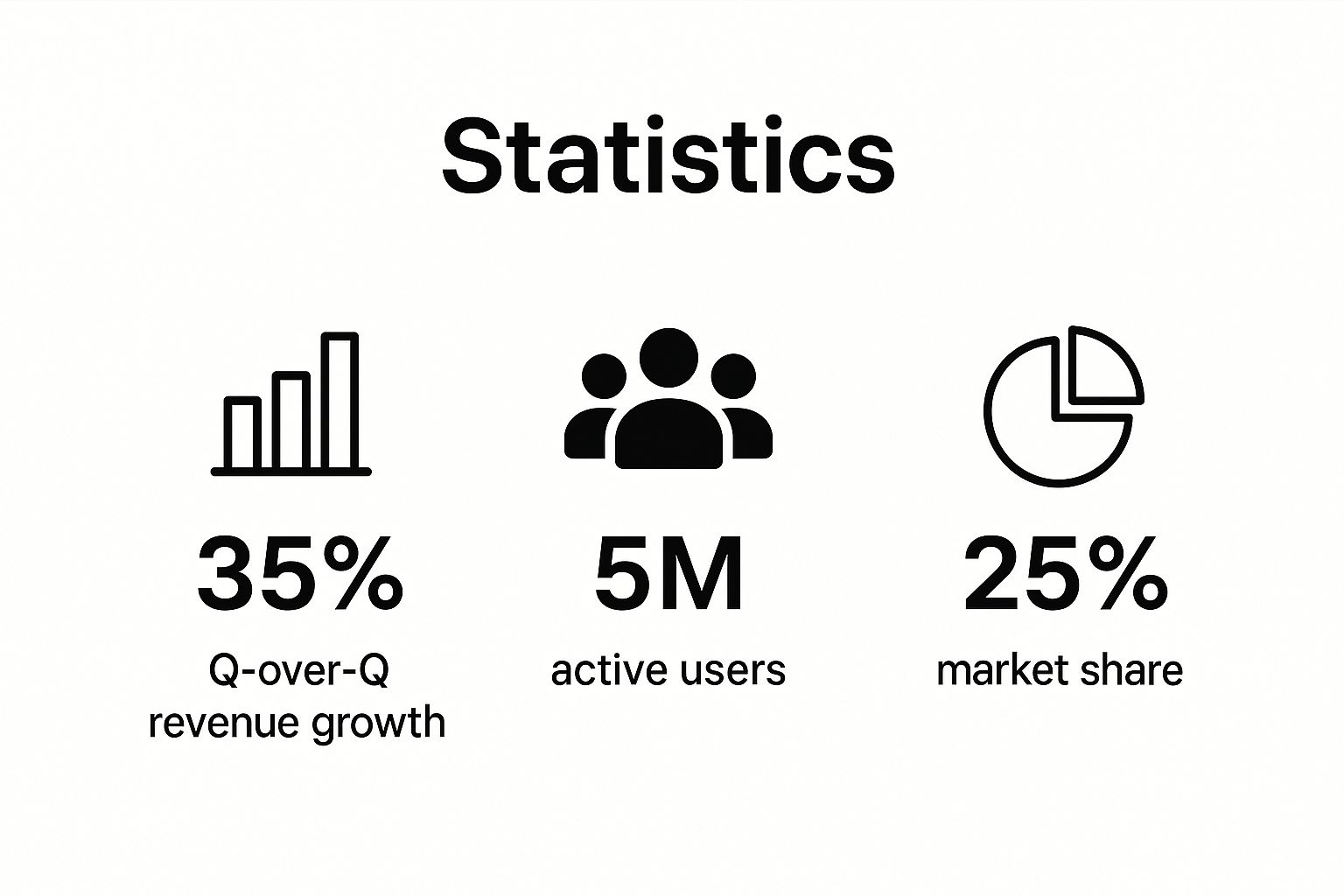
What to Include in a Media Kit: 8 Essentials for 2025
Published
Unlock Press Coverage: Your Ultimate Media Kit Blueprint
In a competitive media environment, securing attention requires more than just a great story; it demands a professional, comprehensive, and easily accessible media kit. This single resource is your brand's calling card to journalists, influencers, and potential partners, often making the difference between a story getting picked up or being passed over. But the crucial question remains: what to include in a media kit to make it truly effective?
This guide demystifies the process, breaking down the eight indispensable components that transform a simple folder of assets into a powerful public relations tool. Whether you're a startup founder, an established brand, or an influencer marketing professional looking to showcase clients, mastering these elements ensures you're always prepared. For a deeper dive into developing compelling narratives and materials for your kit, explore these effective content creation ideas.
We will provide actionable tips, real-world examples, and clear templates for each section. Our goal is to equip you to build a media kit that not only tells your story but sells it, helping you earn the coverage and collaborations you deserve. Let's get started.
1. The Foundational Story: Your Company/Brand Overview
Before a journalist, potential partner, or influencer can write about you, they must first understand who you are. The brand overview is the narrative foundation of your entire media kit and a crucial element when considering what to include in a media kit. This section transcends a dry corporate summary; it's your opportunity to craft a compelling story that encapsulates your company's mission, vision, and core values, setting the tone for everything that follows.

Think of it as your elevator pitch, meticulously refined for media consumption. A powerful overview establishes immediate credibility by giving journalists a clear, quotable summary of your "why," not just your "what." It answers their initial questions, builds an emotional connection, and frames how they perceive your brand from the very beginning. This is where you anchor your identity, differentiate yourself in a crowded market, and ensure your core message is understood instantly.
Why It's Essential
A strong brand overview is your first chance to make an impression and control your narrative. It provides essential context about your identity, purpose, and market position. For instance, Patagonia's media kit doesn't just say they sell outdoor gear; it immediately highlights their environmental activism. This framing ensures that any resulting coverage is likely to include their core mission, which is far more impactful than a simple product mention.
How to Implement It
Crafting a memorable overview requires a strategic approach. Focus on clarity and impact with these actionable tips:
- Lead with Your Differentiator: Start with what makes you unique. Is it your sustainable sourcing, your disruptive technology, or your community-focused mission? State it upfront.
- Tell a Story, Don't Just State Facts: Instead of corporate jargon, use narrative language. Explain the problem you solve and the passion that drives your team. For more inspiration on building a compelling brand narrative, you can see how organizations articulate their mission by exploring the story behind a platform like Influencer Marketing Jobs.
- Include Key Milestones: Mention your founding date and one or two significant achievements. This provides a quick-scan timeline that builds legitimacy.
- Keep it Concise: Aim for 150-200 words. Media professionals are busy; your overview should be digestible in under a minute.
2. High-Resolution Images and Visual Assets
Visuals are the lifeblood of modern media, and providing ready-to-use, professional-quality images is one of the most practical things to include in a media kit. Journalists, bloggers, and partners are constantly searching for compelling visuals to accompany their stories. By offering a curated library of high-resolution assets, you remove a major point of friction, significantly increasing the likelihood that your brand will be featured prominently and presented exactly as you intend.

This section goes beyond simply having a logo file available. It's about providing a comprehensive suite of visual tools that allow media professionals to craft a visually rich narrative about your brand. These assets empower them to create engaging content for their audience, whether for a print magazine spread, a digital article, or a social media post. Providing these materials upfront saves them time, ensures brand consistency, and gives you more control over your visual identity in the public sphere.
Why It's Essential
A well-stocked visual asset library makes a journalist's job easier, which is always a winning strategy. When a media outlet is on a tight deadline, having immediate access to approved, high-quality images can be the deciding factor between your brand being featured or passed over. For instance, Apple’s media resources include pristine product shots on white backgrounds and in lifestyle contexts, ensuring their products are always shown in the best possible light, no matter the publication. Beyond just high-resolution images, your media kit should clearly define what constitutes your core brand assets, which are essential for consistent messaging.
How to Implement It
Organizing your visual assets for easy access is key. Focus on quality, variety, and clear guidelines with these tips:
- Offer Multiple Resolutions: Provide images optimized for different platforms. Include high-resolution (300 DPI) versions for print and web-optimized (72 DPI) versions for digital use.
- Include a Variety of Assets: Go beyond just logos. Include high-quality product photos, executive headshots, lifestyle shots showing your product in use, and even office or behind-the-scenes images.
- Provide Clear Usage Guidelines: Briefly state any required photo credits or restrictions. This clarity prevents misuse and protects your brand. For a deeper look at asset compilation, learn more about how to assemble these elements when creating your own media kit.
- Use Accessible Storage: Host your files in an easily downloadable format using a cloud service like Google Drive or Dropbox. Organize them into clearly labeled folders (e.g., "Logos," "Product Shots," "Headshots").
3. Executive Biographies and Key Personnel Information
Behind every great brand are the people who build it. Executive biographies and key personnel information are essential components when considering what to include in a media kit because they put a human face on your company. This section moves beyond company-level narratives to introduce the thought leaders, founders, and experts who drive your mission. It’s your chance to position your leadership as credible, authoritative sources that journalists will want to quote and interview.

Think of these bios as curated professional stories designed for media consumption. A well-crafted bio doesn't just list career achievements; it highlights the specific expertise and vision that make your executives compelling figures in your industry. This provides journalists with ready-to-use background information, establishes your team's authority, and makes it easy for them to identify the right person for a specific interview or expert commentary request, solidifying your brand’s thought leadership.
Why It's Essential
Including strong executive bios gives your brand a significant advantage by making it easier for journalists to write a richer, more personal story. It transforms your company from a faceless entity into a team of passionate experts. For example, the bio for Salesforce CEO Marc Benioff often emphasizes his philanthropic work and commitment to equality. This positions him not just as a tech CEO but as a thought leader on corporate responsibility, opening doors to a wider range of media coverage.
How to Implement It
Creating impactful bios requires a focus on relevance and personality. Use these actionable tips to make your leadership team stand out:
- Write in the Third Person: This is the standard for media use, as it allows journalists to copy and paste the text directly into their articles without needing to edit pronouns.
- Offer Multiple Lengths: Provide a short bio (around 50 words) for quick mentions and a longer version (150-200 words) with more detail. This gives media professionals the flexibility they need.
- Focus on Industry-Relevant Achievements: Instead of listing every job title, highlight accomplishments that directly relate to your current industry and brand mission. Frame their experience as the foundation of your company's success.
- Include a Professional Headshot: A high-resolution, professional headshot for each featured executive is non-negotiable. It adds a crucial visual and personal element.
4. Key Statistics, Facts, and Company Data
While your brand story builds an emotional connection, hard data builds undeniable credibility. This section is where you provide journalists and partners with quantifiable, newsworthy evidence of your success and market relevance. It's a critical component when deciding what to include in a media kit because it provides concrete facts that can be directly quoted, adding weight and authority to any story. These numbers transform your narrative from a claim into a proven reality.

Think of this section as the fact sheet that backs up your pitch. When a company can share data points like a 35% quarter-over-quarter revenue growth, its achievement becomes tangible. It’s not just growing; it's growing at a specific, impressive rate. This infographic visually represents how you can showcase significant metrics, such as reaching five million active users or capturing a 25% market share, in a clear and compelling format. By presenting verifiable achievements, you make it easy for the media to frame your company as a significant player in your industry.
Why It's Essential
Providing key statistics saves journalists valuable research time and gives them ready-made proof points to strengthen their articles. Companies like Netflix consistently report subscriber growth, which becomes a headline in itself. Similarly, when Zoom experienced a massive user surge, its media kit highlighted these figures, turning the company into a central character in the remote work story. These numbers are not just metrics; they are powerful narrative tools that demonstrate impact, growth, and market leadership.
How to Implement It
Curating your data requires a focus on what is most impressive and relevant. Use these tips to select and present your stats effectively:
- Highlight Growth and Scale: Prioritize metrics that show momentum, such as user growth, revenue increases, or expansion into new markets. Year-over-year or quarter-over-quarter comparisons are particularly powerful.
- Keep it Current and Verifiable: Ensure all statistics are up-to-date, ideally refreshed quarterly. Every number must be accurate and approved for public release to maintain trust.
- Provide Context: Don’t just list a number; explain its significance. A metric of "5 million users" is more impactful when framed as "reaching 5 million active users in our first two years."
- Use Rounded, Quotable Numbers: Simplify complex figures. "Over 100,000 downloads" is easier for a journalist to quote and for an audience to remember than "103,457 downloads."
5. Recent Press coverage and Media Mentions
After establishing who you are and what you do, the next step is to show, not just tell, your newsworthiness. A curated section of recent press coverage and media mentions acts as powerful social proof. This part of your media kit demonstrates that your story has already been validated by other reputable outlets, making it a critical element when deciding what to include in a media kit.
Think of this section as a highlight reel of your public relations successes. For a busy journalist, seeing that outlets like Forbes, TechCrunch, or a respected industry journal have already covered you significantly lowers their perceived risk. It signals that your brand is credible, your narrative is compelling, and there's an existing audience interested in what you have to say. This immediately elevates your pitch from an unknown entity to a proven story.
Why It's Essential
Including past coverage builds instant credibility and momentum. It shows journalists that you understand the media landscape and have a story worth telling. For example, a startup like Slack featuring mentions from The Wall Street Journal not only showcases its business relevance but also provides a template for the kind of high-impact stories other journalists could write. It removes guesswork and builds confidence in your brand's media potential.
How to Implement It
Curating your press mentions effectively requires a focus on quality and presentation. Here’s how to make this section impactful:
- Prioritize Quality Over Quantity: Select your best, most relevant press features. A single article in a top-tier publication is more impressive than ten mentions on unknown blogs.
- Showcase with Logos: Use the official logos of the publications that featured you. This visual shorthand is quickly recognizable and adds a professional touch that text-only links lack.
- Provide Context and a Link: Below each logo, include the article title, a brief, one-sentence summary of the story's angle, and a direct link to the piece. This helps journalists quickly assess the coverage.
- Keep It Current: Feature coverage from the last 12-18 months prominently. You can create an "archive" page for older press, but your main kit should reflect recent momentum.
- Amplify with Testimonials: To further strengthen your social proof, consider how you can integrate other forms of validation. Reviewing powerful customer testimonial examples can inspire ways to blend media praise with customer advocacy for maximum impact.
6. Product or Service Information and Offerings
After establishing your brand's story and who you serve, it's time to detail your "what." The product or service information section is the practical core of your press kit, providing journalists with the specific details they need to accurately and compellingly write about your offerings. This component is essential when determining what to include in a media kit because it transitions from your brand's mission to its tangible market value.
Think of this as a journalist's reference guide. It needs to be clear, comprehensive, and focused on the unique value you provide. A well-crafted product section demystifies your offerings, prevents misinterpretation, and gives the media everything they need to explain how your solution works, who it helps, and why it stands out from the competition. This clarity ensures any coverage is not only accurate but also highlights the features you want to be known for.
Why It's Essential
Without clear product details, you leave journalists to guess, which can lead to inaccurate reporting or a complete lack of specific mentions. This section equips them to write with authority. For example, Shopify's media kit doesn't just say it's an "e-commerce platform"; it breaks down its various subscription tiers, point-of-sale hardware, and enterprise-level solutions. This level of detail enables a writer to craft a specific story, such as "Shopify's New POS Go Device Empowers Pop-Up Shops," which is far more powerful than a generic mention.
How to Implement It
Structure this information logically to make it easily scannable and understandable. Focus on providing clarity and showcasing value with these tips:
- Organize by Product Lines or Solutions: Group your offerings into logical categories. If you have a software suite, break it down by feature modules. If you sell physical products, categorize them by collection or use case.
- Use Clear, Jargon-Free Language: Avoid internal acronyms or overly technical terms. Explain functionalities and benefits in a way that a non-expert can immediately grasp and relay to their audience.
- Highlight Key Features and Differentiators: For each product or service, use bullet points to list the top 3-5 features that make it unique. Answer the question: "What can this do that others can't?"
- Include Pricing and Availability: Provide clear pricing information or a link to your pricing page. Mention where the product or service is available (e.g., globally, specific countries, online-only).
7. Contact Information and Media Relations Details
After presenting your story, your achievements, and your assets, the final step is to make it incredibly easy for the media to connect with you. This section is the functional gateway of your media kit; without it, all the compelling content you’ve curated loses its purpose. Including clear and comprehensive contact information is a non-negotiable part of what to include in a media kit, ensuring a journalist's interest can quickly turn into a tangible conversation or interview.
Think of this section as the call to action for media professionals. A well-organized contact page removes friction and demonstrates your professionalism and readiness to engage. It tells journalists, influencers, and potential partners that you are accessible, responsive, and prepared to provide them with the information they need to do their jobs effectively. This simple yet critical detail can be the difference between getting coverage and being passed over for a more accessible source.
Why It's Essential
Your media kit's primary goal is to generate media interest and coverage. If a journalist on a tight deadline cannot immediately find the right person to contact, they will simply move on. Providing direct, accurate, and segmented contact details shows respect for their time and streamlines their workflow. For example, a global brand like Microsoft provides different contacts for product, corporate, and regional inquiries, ensuring reporters reach a relevant expert quickly. This level of organization builds trust and positions your brand as a reliable source.
How to Implement It
Organize your contact details for maximum clarity and efficiency. The goal is to guide the user to the correct point of contact without any confusion.
- Designate a Primary Media Contact: Clearly label your main point person for all media inquiries. Provide their name, title, email address, and a direct phone number.
- Segment Contacts by Need: If applicable, provide different contacts for specific requests. You might have separate contacts for product reviews, interview requests with executives, or partnership opportunities.
- Include Executive Availability: Mention which founders or key executives are available for interviews or expert commentary. This proactively answers a common media question.
- Provide Clear Guidelines: Briefly state the best way and time to reach out. For global companies, including your primary time zone is a crucial courtesy. To see how to present contact information clearly, you can explore the structure used for different inquiries by reviewing the contact options at Influencer Marketing Jobs.
8. Awards, Recognition, and Notable Achievements
While your brand story explains who you are, awards and recognition provide external validation of your excellence. This section of your media kit acts as a powerful trust signal, showcasing third-party endorsements that build immediate credibility. It’s a crucial element when considering what to include in a media kit because it moves your claims from self-proclaimed to industry-verified, giving journalists and partners concrete proof of your authority.
This is your trophy case, carefully curated to tell a story of success and leadership. By presenting notable achievements, you are not just listing accomplishments; you are providing tangible evidence of your impact, quality, and innovation. For a journalist on a tight deadline, these accolades offer compelling, ready-made story angles that highlight your brand as a leader worth covering.
Why It's Essential
Awards and recognition serve as powerful social proof that differentiates you from competitors. They are shortcuts to establishing trust and authority. For example, a B-Corp certification instantly communicates a company’s commitment to high social and environmental standards, a story angle that resonates deeply with conscious consumers and media outlets. Likewise, a tech startup featuring its Y Combinator alumni status or a TechCrunch Disrupt award immediately signals its potential and legitimacy within the venture capital and tech communities.
How to Implement It
Effectively showcasing your achievements requires organization and context. Use these tips to create a section that impresses without overwhelming:
- Organize for Clarity: Group your accolades into logical categories such as "Industry Leadership," "Workplace Culture," "Innovation," or "Product Design." This helps journalists quickly find the information most relevant to their beat.
- Provide Meaningful Context: Don't just list an award's name. Briefly explain what it signifies and include the year it was received. For instance, instead of just "Innovation Award," write "2023 CX Innovation Award for revolutionizing customer support with AI."
- Prioritize the Prestigious: Place your most recent and most impressive awards at the top. Media professionals are drawn to what's current and significant.
- Use Logos for Visual Impact: When permitted by the granting organization, include the official logos for each award. This visual reinforcement breaks up text and adds a layer of authenticity and professionalism to your media kit.
Media Kit Essentials Comparison of 8 Elements
| Item | Implementation Complexity 🔄 | Resource Requirements ⚡ | Expected Outcomes 📊 | Ideal Use Cases 💡 | Key Advantages ⭐ |
|---|---|---|---|---|---|
| Company/Brand Overview | Moderate – requires storytelling finesse | Low to Moderate – content writing and design | Establishes brand identity and credibility | Introducing brand to media, setting tone | Builds emotional connection; quick brand understanding |
| High-Resolution Images and Visual Assets | High – professional photography and formatting | High – investment in equipment and storage | Enhances visual media coverage and brand consistency | Visual storytelling, print and digital coverage | Saves journalists time; improves professionalism |
| Executive Biographies and Key Personnel Information | Moderate – requires accurate, updated bios | Low to Moderate – content creation and updates | Positions leadership as credible media sources | Providing expert quotes and interview sources | Establishes thought leadership; humanizes brand |
| Key Statistics, Facts, and Company Data | Moderate to High – data gathering and validation | Moderate – data management and visualization | Provides credibility and newsworthy content | Quantifiable success proof, media fact-checking | Concrete evidence for stories; demonstrates growth |
| Recent Press Coverage and Media Mentions | Moderate – curation and frequent updates | Low – content organization | Builds social proof and shows media presence | Demonstrating newsworthiness and media relationships | Boosts credibility; inspires new coverage |
| Product or Service Information and Offerings | High – detailed content and technical accuracy | Moderate – cross-functional input | Enables accurate product representation | Detailed product explanations and media reference | Reduces clarification requests; highlights differentiation |
| Contact Information and Media Relations Details | Low – simple but needs accuracy | Low – regular maintenance | Streamlines communication between media and company | Facilitating media inquiries and interview coordination | Ensures proper media outreach; professional image |
| Awards, Recognition, and Notable Achievements | Low to Moderate – requires updating and presentation | Low – collecting and formatting data | Enhances credibility through third-party validation | Showcasing company excellence and trustworthiness | Differentiates brand; provides story angles |
Bringing It All Together: Your Media-Ready Action Plan
Crafting a compelling media kit is far more than a simple box-ticking exercise. It's the strategic assembly of your brand's narrative, credibility, and potential into a single, powerful resource. As we've detailed, each component, from your foundational company overview to your collection of prestigious awards, serves a distinct and vital purpose. Together, they create a cohesive and professional presentation that empowers journalists, partners, and collaborators to understand and feature your story accurately and enthusiastically. Understanding what to include in a media kit is the first step; mastering its execution is what sets successful brands apart.
Think of your media kit not as a static brochure but as a dynamic, living portfolio. It’s an evergreen asset that grows alongside your business. A proactive approach to its maintenance is non-negotiable for sustained media success. When you land a significant press mention, secure a new award, or achieve a noteworthy data milestone, your first procedural step should be to update the relevant sections of your kit. This discipline ensures you are always prepared for opportunity, projecting an image of organization and respect for the tight deadlines journalists operate under.
Your Actionable Next Steps
To transform these insights into tangible results, here is your immediate action plan:
- Conduct a Content Audit: Systematically review your existing assets against the eight core elements discussed. Identify what you have, what’s outdated, and what’s missing entirely. This gap analysis forms the basis of your to-do list.
- Establish a "Living Document" System: Choose a platform for your media kit that is easy to update. A dedicated, password-protected page on your website or a cloud-based folder (like Google Drive or Dropbox) with a shareable link is ideal. This prevents the circulation of outdated PDF attachments.
- Schedule Quarterly Reviews: Set a recurring calendar reminder for your team to review and refresh the media kit every three months. This cadence is frequent enough to keep content current without being overly burdensome. During this review, update your statistics, add recent press coverage, and swap in new high-resolution visual assets.
- Create Tailored Versions: While your core media kit should be comprehensive, consider creating streamlined versions for specific purposes. For example, a one-page version with just the highlights might be perfect for an initial outreach email, with a link to the full kit for those who are interested.
The Lasting Impact of a Professional Media Kit
Ultimately, a well-crafted media kit is an investment in your brand’s reputation and a catalyst for growth. It streamlines your public relations efforts, minimizes back-and-forth communication, and equips media professionals with everything they need to tell your story compellingly. It demonstrates that you are a serious, professional organization ready for the spotlight. This level of preparation doesn’t just attract media attention; it builds lasting relationships based on mutual respect and efficiency. By thoughtfully curating what to include in a media kit, you are not just providing information, you are controlling your narrative and paving the way for powerful, positive exposure.
For marketing professionals looking to build or advance their careers, mastering brand storytelling and media relations is essential. Many top-tier roles demand expertise in creating these exact types of strategic assets. To find your next opportunity where these skills are valued, explore the specialized listings on Influencer Marketing Jobs.